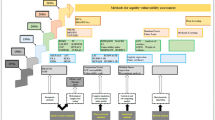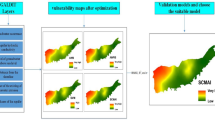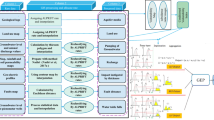Abstract
DRASTIC-based vulnerability indices and their variations for an aquifer are investigated in this paper, each of which is regarded as a framework since their rationale of using seven DRASTIC data layers is consensual and lacks empirical or theoretical formulations. The Basic DRASTIC framework (BDF) is implemented by a set of prescribed rules; whereas its three variations involve unsupervised learning from the data, which comprise: (i) learning the rates by the Wilcoxon test (WDF) but using BDF weights; (ii) using BDF rates but learning the weights by Genetic Algorithm (BDF-GA); and (iii) learning rates as in WDF and the weights as in BDF-GA (WDF-GA). These four frameworks are not supervised, but the novelty of the paper is to introduce supervised learning at the second stage by Artificial Intelligence to run Multiple Frameworks (AIMF), for which the paper uses Support Vector Machine (SVM). AIMF uses the outputs of the four frameworks as its input data and a function of observed nitrate-N values as its target data. The AIMF strategy is evaluated in the aquifer of Ardabil plain, which is exposed to anthropogenic contamination such as nitrate-N. The coefficient of correlation (r-values) between the results and nitrate-N values for the above frameworks are: 0.2, 0.37, 0.38 and 0.45; whereas AIMF enhances it to 0.84; attributable to the supervised learning.




Similar content being viewed by others
References
Aller L, Bennett T, Lehr JH, Petty RJ, Hackett G (1987) DRASTIC: A Standardized System for Evaluating Ground Water Pollution Potential Using Hydrogeologic Settings. EPA 600/2–87-035. U.S. Environmental Protection Agency, Ada, Oklahoma
Asadi S, Hassan M, Nadiri AA, Dylla H (2014) Artificial intelligence modeling to evaluate field performance of photocatalytic asphalt pavement for ambient air purification. Environ Sci Pollut Res 21(14):8847–8857. https://doi.org/10.1007/s11356-014-2821-z
Bai L, Wang Y, Meng F (2012) Application of DRASTIC and extension theory in the groundwater vulnerability evaluation. Water and Environment journal 26(3):381–391
Bello-Dambatta A, Farmani R, Javadi AA, Evans BM (2009) The Analytical Hierarchy Process for contaminated land management. Adv Eng Inform 23(4):433–441. https://doi.org/10.1016/j.aei.2009.06.006
Civita M (1994) Le carte della vulnerabilita` degli acquiferi all’inquinamento Teoria & practica (Aquifer vulnerability maps to pollution) (in Italian). Pitagora Ed, Bologna, p 325
Daly D, Drew D (1999) Irish methodologies for karst aquifer protection. In: Beek B (ed) Hydrogeology and engineering geology of sinkholes and karst. Balkema, Rotterdam, pp 267–327
Davis L (1991) Handbook of Genetic Algorithms. Van Nostrand Reinhold, New York
Foster S (1987) Fundamental concepts in aquifer vulnerability, pollution risk and protection strategy. international conference Noordwijk a Zee, Netherlands, 1–30 Apri 1987
Holland JH (1975) Adaptation in natural and artificial systems. University of Michigan, Ann Arbor
Huan H, Wang J, Teng Y (2012) Assessment and validation of groundwater vulnerability to nitrate based on a modified DRASTIC model: A case study in Jilin City of northeast China. Sci Total Environ 440:14–23. https://doi.org/10.1016/j.scitotenv.2012.08.037
Jafari SM, Nikoo MR (2016) Groundwater risk assessment based on optimization framework using DRASTIC method. Arab J Geosci 9:742. https://doi.org/10.1007/s12517-016-2756-4
Kauffman LJ, Chapelle FH (2010) Relative vulnerability of public supply wells to VOC contamination in hydrologically distinct regional aquifers. Ground Water Monit Remediat 30:54–63. https://doi.org/10.1111/j.1745-6592.2010.01308.x
Khatibi R, Ghorbani MA, Akhoni Pourhosseini F (2017) Stream flow predictions using nature-inspired Firefly Algorithms and a Multiple Model strategy – Directions of innovation towards next generation practices. Journal of Advanced Engineering Informatics. http://www.sciencedirect.com/science/article/pii/S1474034617301271
McLay CDA, Dragden R, Sparling G, Selvarajah N (2001) Predicting groundwater nitrate concentrations in a region of mixed agricultural land use: a comparison of three approaches. Environ Pollut 115:191–204
Mitchell M (1996) An Introduction to Genetic Algorithms. Massachusetts Institute of Technology
Nadiri AA, Fijani E, Tsai FT-C, Moghaddam AA (2013) Supervised committee machine with artificial intelligence for prediction of fluoride concentration. J Hydroinf 15(4):1474–1490. https://doi.org/10.2166/hydro.2013.008
Nadiri AA, Gharekhani M, Khatibi R, Asghari Moghaddam A (2017b) Assessment of groundwater vulnerability using supervised committee to combine fuzzy logic models. Environ Sci Pollut Res 24(9):8562–8577. https://doi.org/10.1007/s11356-017-8489-4
Nadiri AA, Gharekhani M, Khatibi R, Sadeghfam S, Asghari Moghaddam A (2017a) Groundwater vulnerability indices conditioned by Supervised Intelligence Committee Machine (SICM). Sci Total Environ 574:691–706. https://doi.org/10.1016/j.scitotenv.2016.09.093
Nadiri AA, Sedghi Z, Khatibi R, Gharekhani M (2017c) Mapping vulnerability of multiple aquifers using multiple models and fuzzy logic to objectively derive model structures. Sci Total Environ 593-594:75–90. https://doi.org/10.1016/j.scitotenv.2017.03.109
Najib S, Grozavu A, Khalid Mehdi KM, Breabăn IG, Guessir H, Boutayeb K (2012). Application of the method GALDIT for the cartography of groundwaters vulnerability: aquifer of Chaouia coast (Morocco). Analele Stiintifice ale Universitatii “Al. I. Cuza” din Iasi. Serie Noua. Geografie, 2012, vol. 58, No 2, p. 77
Ribeiro L (2000) Desenvolvimento de um ı’ndice para avaliar a susceptibilidade. ERSHA-CVRM, 8
Rupert MG (1999) Improvements to the DRASTIC groundwater vulnerability mapping method. US Geol Surv Fact Sheet FS-066-99
Sadeghfam S, Hassanzadeh Y, Nadiri AA, Zarghami M (2016a) Localization of groundwater vulnerability assessment using catastrophe theory. Water Resour Manag 30(13):4585–4601. https://doi.org/10.1007/s11269-016-1440-5
Sadeghfam S, Hassanzadeh Y, Nadiri AA, Khatibi R (2016b) Mapping groundwater potential field using catastrophe fuzzy membership functions and Jenks optimization method: a case study of Maragheh-Bonab plain, Iran. Environmental Earth Sciences 75(7):545. https://doi.org/10.1007/s12665-015-5107-y
Sorichetta A, Masetti M, Ballabio C, Sterlacchini S (2012) Aquifer nitrate vulnerability assessment using positive and negative weights of evidence methods, Milan, Italy. Comput Geosci 48:199–210
Suykens JAK (2000) Least squares support vector machines for classification and nonlinear modelling. Neural Network World. Special Issue on PASE 2000, 10 (1–2), 29–48
Suykens JAK, Van GT, Brabanter JD, De MB, Vandewalle J (2002) Least Squares Support Vector Machines. World Scientific Publishing, Singapore
Tayfur G, Nadiri AA, Moghaddam AA (2014) Supervised intelligent committee machine method for hydraulic conductivity estimation. Water Resour Manag 28(4):1173–1184. https://doi.org/10.1007/s11269-014-0553-y
Tesoriero AJ, Inkepan EL, Voss FD (1998) Assessing groundwater vulnerability using logistic regression. In: proceedings for the source water assessment and protection 98 conference. Dallas:157–165
USEPA (2012) National Primary Drinking Water Regulations. US Environmental Protection Agency, EPA816-F-09-004
Van Stemproot D, Evert L, Wassenaar L (1993) Aquifer vulnerability index: a GIS compatible method for groundwater vulnerability mapping. Canadian Water Resources Journal 18:25–37. https://doi.org/10.4296/cwrj1801025
Wilcoxon F (1945) Individual comparisons by ranking methods. Biom Bull 1:80–83. https://doi.org/10.2307/3001968
Wu W, Yin S, Liu H, Chen H (2014) Groundwater Vulnerability Assessment and Feasibility Mapping Under Reclaimed Water Irrigation by a Modified DRASTIC Model. Water Resour Manag 28(5):1219–1234. https://doi.org/10.1007/s11269-014-0536-z
Author information
Authors and Affiliations
Corresponding author
Ethics declarations
Conflict of Interest
None.
Rights and permissions
About this article
Cite this article
Nadiri, A.A., Gharekhani, M. & Khatibi, R. Mapping Aquifer Vulnerability Indices Using Artificial Intelligence-running Multiple Frameworks (AIMF) with Supervised and Unsupervised Learning. Water Resour Manage 32, 3023–3040 (2018). https://doi.org/10.1007/s11269-018-1971-z
Received:
Accepted:
Published:
Issue Date:
DOI: https://doi.org/10.1007/s11269-018-1971-z




